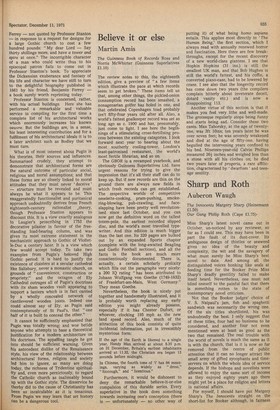Believe it or else
Martin Amis
The Guinness Book of Records Ross and Norris McWhirter (Guinness Superlatives E1.10) The review notes to this, the eighteenth edition, give a preview of "a few items which illustrate the pace at which records seem to get broken." These items tell us that, among other things, the pickled-onion consumption record has been smashed, a nonagenarian golfer has holed in one, and that celebrated Copenhagen toad probably isn't fifty-four years old after all. Also, a world's fattest goalkeeper record was set as long ago as c. 1900 and has, presumably, just come to light. I see here the beginnings of a stimulating cross-fertilising process between the existing categories. I look forward next year to hearing about the most southerly cooling-tower, London's least-patronised restaurant, the world's most fertile librarian, and so on.
The GBOR is a revamped yearbook, and obviously Guinness Superlatives Ltd. have urgent reasons for trying to give the impression that it's all their staff can do to keep up. But if new records are thin on the ground there are always new fields in which fresh records can get established. The respective worlds of competitive omelette-cooking, pram-pushing, smokering-blowing, pub-crawling, and faceslapping have been pretty well revolutionised since last October, and you can now get the definitive word on the tallest totem-pole, the earliest recorded slipped disc, and the world's most travelled typewriter. And this edition is much bigger than the last one. Its 320 pages are bulked out by an expanded Sports chapter (complete with the long-awaited Beagling and Gaelic Football sections), and all the facts in the book are much more conscientiously documented. There is, actually, a certain scholarly prolixity which fills out the paragraphs very nicely: a 200 IQ rating "has been attributed to Johann Wolfgang von Goethe (1749-1832) of Frankfurt-am-Main, West Germany." They mean Goethe.
Nevertheless, the book is nicely put together and handsomely illustrated, and it is probably worth replacing any early edition you might already possess, especially if it has Chester Dufort, or whoever, clocking 195 mph as the new land speed record. Also, much of the attraction of this book consists of quite incidental information, put in irresistibly mysterious form: If the age of the Earth is likened to a single year, Handy Man arrived at about 8.35 p.m. on 31 December, Britain's earliest inhabitants arrived at 11.32, the Christian era began 13 seconds before midnight.
In Chinese, the fourth tone of T has 84 meanings, varying as widely as "dress," "hiccough," and "licentious."
Furthermore, it would be dishonest to deny the remarkable believe-it-or-else compulsion of this durable series. Every superlative in the book does something towards increasing one's conception (there is — unfortunately — no other way of putting it) of what being homo sapiens entails. This applies most directly to The Human Being,' the first section, which I always read with annually renewed horror and fascination. Here there are few breakthroughs, except for the recent discovery of a new world-class giantess. I see that Hopkin Hopkins (31 ins.) is still the smallest UK man, and that Bob Hughes is still the world's fattest, and his coffin, a converted piano-case, had to be lowered by crane. I see also that the longevity record has come down two years (the compilers complain bitterly about inveterate deceit, dotard vanity etc.) and is now a disappointing 113.
Another virtue of this section is that it makes you feel very lithe and well-made. The grotesque regularly stops being funny and starts being sad. Consider these two cases. Max Taborsky, at the age of twentyone, was 3ft 10ins; ten years later he was over seven feet; he was severely weakened and died at the age of fifty-one, having beguiled the intervening years confined to his bed. Nineteen-year-old Calvin Phillips measured 26/ inches and weighed less than a stone with all his clothes on; he died two years later of pro geria, a rare affiliction, characterised by ' dwarfism ' and teenage senility.










































 Previous page
Previous page